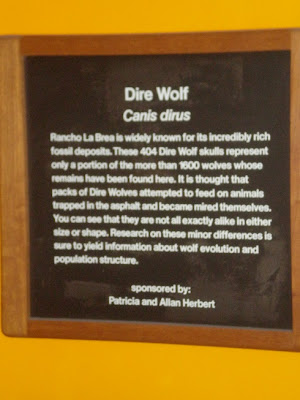The La Brea tar pits are in the middle of greater Los Angeles on Wilshire Boulevard. The area is now a single large city block that contains the remaining tar pits and the Page Museum.
The tar pits are composed of thick black asphalt and usually there are bubbles of methane forming on the surface. The largest pit was mined for the asphalt in the early 1900's and now it's a dirty-looking lake with methane bubbles.
The Page Museum contains some of the fossils that have been removed from the pits. (You can see an evacuation in progress at Pit 23.) These plants, insects, and animals date from about 40,000 years ago to about 11,000 years ago. The panorama below show the main species: mastodons, juniper trees, saber-toothed cats, camels, Dire wolves, ground sloths, horses, bisons, and a variety of currently extant small animals.
The museum is well worth a visit if you are in the Los Angeles area and you are interested in evolution. Creationists will not like it.
There are millions of fossils and this allows paleontologists to look at variation within a species. There's a nice display of 404 Dire wolf skulls to illustrate the point.
Here's an example of a small tar pit.
Granddaughter Zoë liked the museum but the grassy hills outside the building were an even bigger hit with all the young children. They could climb to the top and roll down to the bottom. Zoë did this several hundred times before we had to get in the car. She was sad to leave the La Brea Tar Pits.







No comments:
Post a Comment